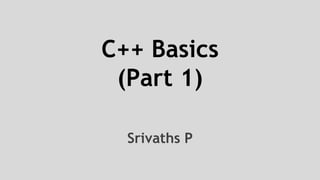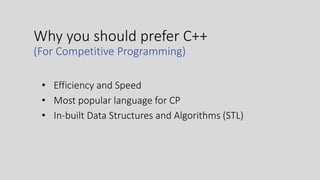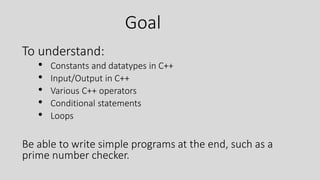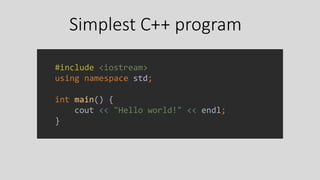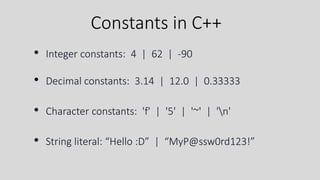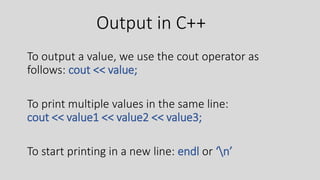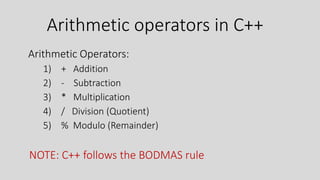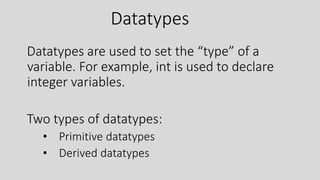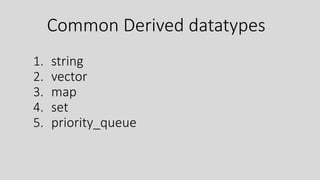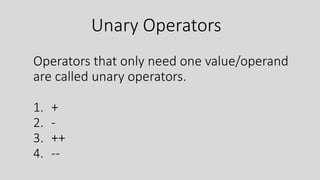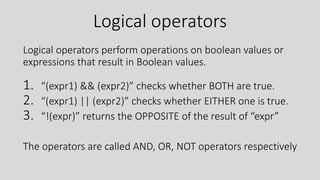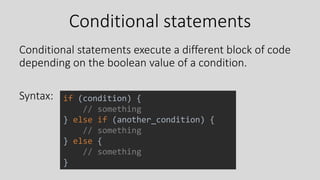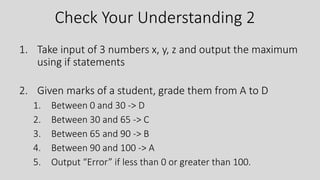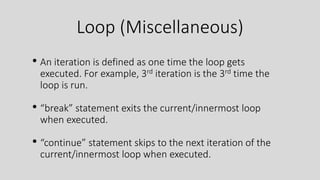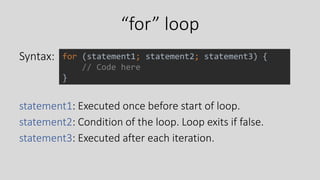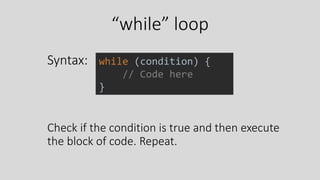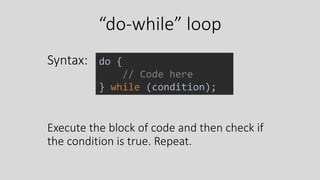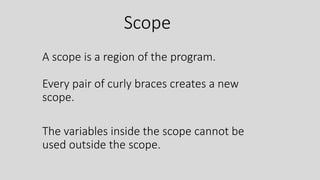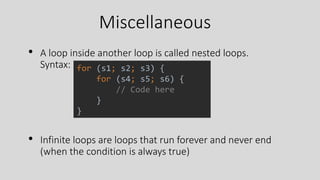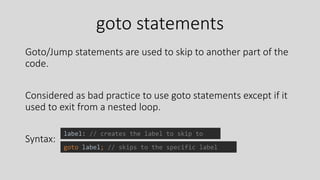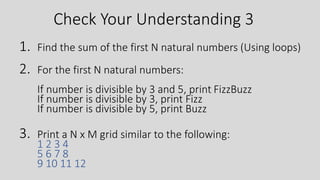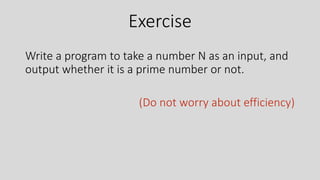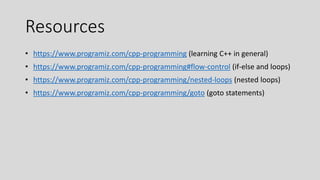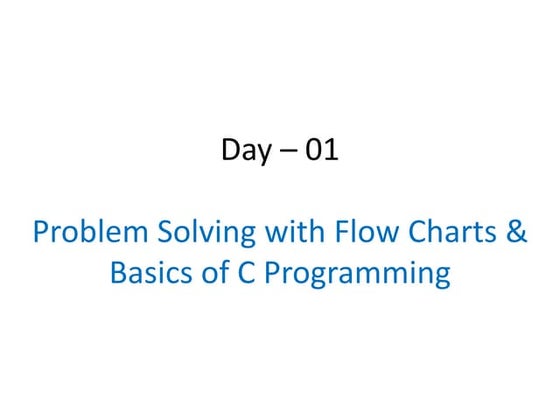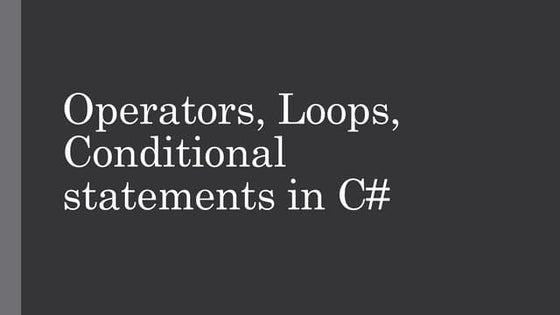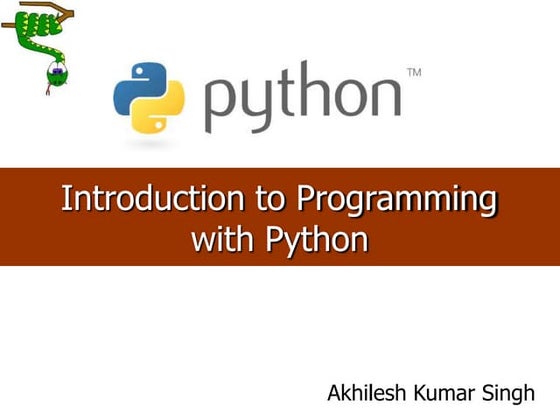C_BASICS FOR C PROGRAMMER WITH SRIVATHS P
- 2. Why you should prefer C++ (For Competitive Programming) ŌĆó Efficiency and Speed ŌĆó Most popular language for CP ŌĆó In-built Data Structures and Algorithms (STL)
- 3. Goal To understand: ŌĆó Constants and datatypes in C++ ŌĆó Input/Output in C++ ŌĆó Various C++ operators ŌĆó Conditional statements ŌĆó Loops Be able to write simple programs at the end, such as a prime number checker.
- 4. Simplest C++ program #include <iostream> using namespace std; int main() { cout << "Hello world!" << endl; }
- 5. Constants in C++ ŌĆó Integer constants: 4 | 62 | -90 ŌĆó Decimal constants: 3.14 | 12.0 | 0.33333 ŌĆó Character constants: 'f' | '5' | '~' | 'n' ŌĆó String literal: ŌĆ£Hello :DŌĆØ | ŌĆ£MyP@ssw0rd123!ŌĆØ
- 6. Output in C++ To output a value, we use the cout operator as follows: cout << value; To print multiple values in the same line: cout << value1 << value2 << value3; To start printing in a new line: endl or ŌĆśnŌĆÖ
- 7. Arithmetic operators in C++ Arithmetic Operators: 1) + Addition 2) - Subtraction 3) * Multiplication 4) / Division (Quotient) 5) % Modulo (Remainder) NOTE: C++ follows the BODMAS rule
- 8. Variables Variables are containers that stores specific types of data. They can be modified with the assignment operator ŌĆ£=ŌĆØ Syntax: datatype variable_name = value;
- 9. Variables Variable names cannot: ŌĆó Have spaces (use underscore instead) ŌĆó Start with a digit ŌĆó Be reserved by the compiler ŌĆó Already taken by another variable (in the same scope) NOTE: Keywords/Variables are case sensitive
- 10. Datatypes Datatypes are used to set the ŌĆ£typeŌĆØ of a variable. For example, int is used to declare integer variables. Two types of datatypes: ŌĆó Primitive datatypes ŌĆó Derived datatypes
- 11. Common Primitive datatypes 1. int (long long int, unsigned int, etc.) 2. char 3. bool 4. float (double, long double) 5. Special type: void
- 12. Common Derived datatypes 1. string 2. vector 3. map 4. set 5. priority_queue
- 13. Arithmetic Assignment Operators 1. += 2. -= 3. *= 4. /= 5. %=
- 14. Unary Operators Operators that only need one value/operand are called unary operators. 1. + 2. - 3. ++ 4. --
- 15. Input in C++ To output a value, we use the cin operator as follows: cin >> value; To print multiple values in the same line: cin >> value1 >> value2 >> value3; NOTE: Each value must be separated by a space or a new line when taking input.
- 16. Check your understanding - 1 1. How will you declare a character equal to exclamatory mark? 2. Take an integer input, and output the value multiplied by 7. 3. Take two values a, b as input, and output three values: a+b and a*b and a/b a/b should be a decimal, not an integer
- 17. Conditions and Relational Operators Conditions return a boolean value depending on whether the expression is true or false. Conditional operators: ==, != Relational operators: <, >, <=, >=
- 18. Logical operators Logical operators perform operations on boolean values or expressions that result in Boolean values. 1. ŌĆ£(expr1) && (expr2)ŌĆØ checks whether BOTH are true. 2. ŌĆ£(expr1) || (expr2)ŌĆØ checks whether EITHER one is true. 3. ŌĆ£!(expr)ŌĆØ returns the OPPOSITE of the result of ŌĆ£exprŌĆØ The operators are called AND, OR, NOT operators respectively
- 19. Conditional statements Conditional statements execute a different block of code depending on the boolean value of a condition. Syntax: if (condition) { // something } else if (another_condition) { // something } else { // something }
- 20. Check Your Understanding 2 1. Take input of 3 numbers x, y, z and output the maximum using if statements 2. Given marks of a student, grade them from A to D 1. Between 0 and 30 -> D 2. Between 30 and 65 -> C 3. Between 65 and 90 -> B 4. Between 90 and 100 -> A 5. Output ŌĆ£ErrorŌĆØ if less than 0 or greater than 100.
- 21. Loop Loops are used to repeat a block of code until some condition is satisfied. There are three types of loops in C++: 1. for loop 2. while loop 3. do-while loop
- 22. Loop (Miscellaneous) ŌĆó An iteration is defined as one time the loop gets executed. For example, 3rd iteration is the 3rd time the loop is run. ŌĆó ŌĆ£breakŌĆØ statement exits the current/innermost loop when executed. ŌĆó ŌĆ£continueŌĆØ statement skips to the next iteration of the current/innermost loop when executed.
- 23. ŌĆ£forŌĆØ loop Syntax: statement1: Executed once before start of loop. statement2: Condition of the loop. Loop exits if false. statement3: Executed after each iteration. for (statement1; statement2; statement3) { // Code here }
- 24. ŌĆ£whileŌĆØ loop Syntax: Check if the condition is true and then execute the block of code. Repeat. while (condition) { // Code here }
- 25. ŌĆ£do-whileŌĆØ loop Syntax: Execute the block of code and then check if the condition is true. Repeat. do { // Code here } while (condition);
- 26. Scope A scope is a region of the program. Every pair of curly braces creates a new scope. The variables inside the scope cannot be used outside the scope.
- 27. Miscellaneous ŌĆó A loop inside another loop is called nested loops. Syntax: ŌĆó Infinite loops are loops that run forever and never end (when the condition is always true) for (s1; s2; s3) { for (s4; s5; s6) { // Code here } }
- 28. goto statements Goto/Jump statements are used to skip to another part of the code. Considered as bad practice to use goto statements except if it used to exit from a nested loop. Syntax: label: // creates the label to skip to goto label; // skips to the specific label
- 29. Check Your Understanding 3 1. Find the sum of the first N natural numbers (Using loops) 2. For the first N natural numbers: If number is divisible by 3 and 5, print FizzBuzz If number is divisible by 3, print Fizz If number is divisible by 5, print Buzz 3. Print a N x M grid similar to the following: 1 2 3 4 5 6 7 8 9 10 11 12
- 30. Exercise Write a program to take a number N as an input, and output whether it is a prime number or not. (Do not worry about efficiency)
- 31. Resources ŌĆó https://www.programiz.com/cpp-programming (learning C++ in general) ŌĆó https://www.programiz.com/cpp-programming#flow-control (if-else and loops) ŌĆó https://www.programiz.com/cpp-programming/nested-loops (nested loops) ŌĆó https://www.programiz.com/cpp-programming/goto (goto statements)
- 32. Thank you!
